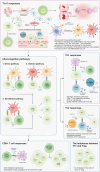Targeting T helper 17 cells: emerging strategies for overcoming transplant rejection
- PMID: 39743231
- PMCID: PMC11732763
- DOI: 10.4285/ctr.24.0058
Targeting T helper 17 cells: emerging strategies for overcoming transplant rejection
Abstract
Solid organ transplantation has significantly improved the survival rate of patients with terminal organ failure. However, its success is often compromised by allograft rejection, a process in which T helper 17 (Th17) cells play a crucial role. These cells facilitate rejection by enhancing neutrophil infiltration into the graft and by activating endothelial cells and fibroblasts. Additionally, Th17 cells can trigger the activation of other T cell types, including Th1, Th2, and CD8+ T cells, further contributing to rejection. An imbalance between Th17 and regulatory T cells (Tregs) is known to promote rejection. To counteract this, immunosuppressive drugs have been developed to inhibit T cell activity and foster transplant tolerance. Another approach involves the adoptive transfer of regulatory cells, such as Tregs and myeloid-derived suppressor cells, to dampen T cell functions. This review primarily focuses on the roles of Th17 cells in rejection and their interactions with other T cell subsets. We also explore various strategies aimed at suppressing T cells to induce tolerance.
Keywords: Allograft rejection; Immune tolerance; Th17 cells; Transplantation.
Conflict of interest statement
No potential conflict of interest relevant to this article was reported.
Figures



Similar articles
-
T helper subsets & regulatory T cells: rethinking the paradigm in the clinical context of solid organ transplantation.Int J Immunogenet. 2014 Jun;41(3):185-94. doi: 10.1111/iji.12106. Epub 2014 Feb 3. Int J Immunogenet. 2014. PMID: 24495112 Review.
-
Knockout of microRNA-155 ameliorates the Th1/Th17 immune response and tissue injury in chronic rejection.J Heart Lung Transplant. 2017 Feb;36(2):175-184. doi: 10.1016/j.healun.2016.04.018. Epub 2016 May 6. J Heart Lung Transplant. 2017. PMID: 27296836
-
Double deficiency for RORγt and T-bet drives Th2-mediated allograft rejection in mice.J Immunol. 2013 Oct 15;191(8):4440-6. doi: 10.4049/jimmunol.1301741. Epub 2013 Sep 20. J Immunol. 2013. PMID: 24058178
-
CD4(+) T-cell subsets in transplantation.Immunol Rev. 2013 Mar;252(1):183-91. doi: 10.1111/imr.12038. Immunol Rev. 2013. PMID: 23405905 Review.
-
The imbalance between Tregs, Th17 cells and inflammatory cytokines among renal transplant recipients.BMC Immunol. 2015 Sep 23;16:56. doi: 10.1186/s12865-015-0118-8. BMC Immunol. 2015. PMID: 26400627 Free PMC article.
References
Publication types
LinkOut - more resources
Full Text Sources
Research Materials

